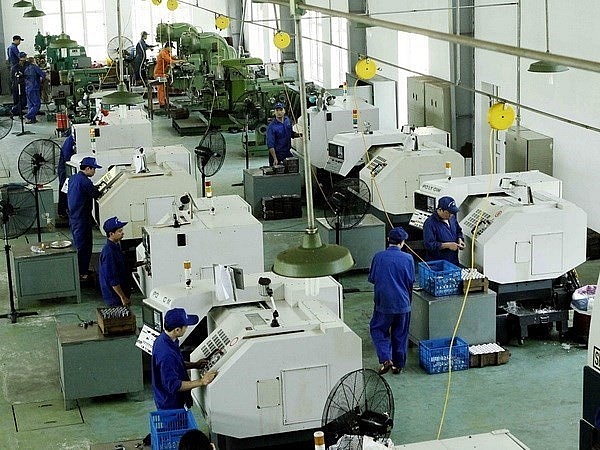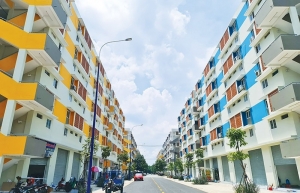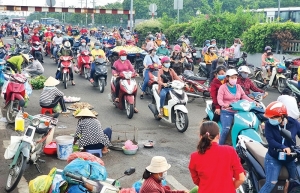Developers struggle with regulations to build worker homes
At the start of the month, Prime Minister Pham Minh Chinh urged governmental agencies to map out a plan to build one million social housing units for workers and low-income people by the end of the decade.
At a conference to promote social housing for workers and low-income people held in Hanoi on August 1, PM Chinh said that providing housing for people, especially workers and low-income earners, is a top priority of the Party and government.
 |
| Developers struggle with regulations to build worker homes, illustration photo |
Responding to the importance, Dinh Sy Phuc, trade union chairman of Dong Nai-based Taekwang Vina JSC, told VIR that the company has approximately 40,000 employees and most of them come from other cities and province, thus the demand for housing is urgent.
“We are facing fiercer competition in attracting labour. The situation is forecast to be more serious in the context of foreign investors shifting to Vietnam. Thus, we have to offer more welfare to retain their employees. The most-wanted welfare is stable accommodation and other utilities for their family members such as schools and medical facilities,” Phuc said.
Having the capacity to set up stable accommodation for employees is also an advantage for businesses in negotiating with foreign partners. “With the experience of producing shoes for Nike, we understand that these global groups pay attention to protecting the human rights of workers at their outsourcing suppliers, including how they create favourable working and living conditions for local workers,” Phuc added.
When Taekwang Vina entered Vietnam over 20 years ago, industrial zones (IZs) were not designed to have such facilities. In recent years, being more aware of the importance of arranging stable accommodation for employees, the company worked with local authorities to arrange land for a housing project, but so far has failed to come to an agreement.
“The company has to leave this plan aside temporarily and look for alternative solutions to support employees, for example hiring shuttle buses for transporting employees,” Phuc said.
According to statistics from the Ministry of Planning and Investment, Vietnam currently has 260 IZs operating and more than 16 million workers directly involved in the production system. However, the whole country has only over 200 official social housing projects for workers, at a scale of about 600 hectares.
More than 80 per cent of migrant workers in Ho Chi Minh City have to rent a room in inns. Similarly, Dong Nai province currently has nearly 1.2 million workers, and nearly all of them must rent privately.
Binh Duong, a predominantly industrial development province, has about 1.6 million workers, most from other provinces. Around 200 companies have built houses for their workers, accommodating 50,000 people.
A representative of an industrial real estate developer in the northern province of Nam Dinh told VIR that it is almost impossible to arrange land inside IZs for accommodation buildings.
“Localities often do not want to approve this type of plan because the land prices in the surrounding areas are so expensive. The localities prefer to arrange land plots that are far away from IZs. That is, however, not convenient for developers,” the representative said. “When it comes down to it, many IZ leaders just want to use land to build factories and have not been interested in funding social infrastructure or accommodation.”
Deputy Minister of Planning and Investment Nguyen Thi Bich Ngoc acknowledged the many problems relating to building houses for low-income earners and workers.
“It is necessary to review the laws on planning, urban areas, and construction to ensure the allocation of land for building social housing projects in local planning and urban planning. Besides that, we propose to add regulations that attach the planning of housing facilities to planning for IZs in general,” Ngoc said.
 | Kickstarting upgrades to worker’s housing The high concentration of industrial zones in big cities has attracted a huge number of workers from rural areas. However, improving their living conditions has become a huge problem that local authorities must deal with. |
 | Industrial zone workers: realities in low-quality living quarters Vietnam currently has 260 industrial zones in operation, with 75 more being planned, for over 16 million workers that generate massively for the country’s GDP. Industrial zone and social housing developers currently only meet less than 10 per cent of the demand, with other workers forced to rent in low-quality, dark, and humid hostels. Developing social housing and housing for workers and ensuring socioeconomic development and quality of life, therefore, is deemed an urgent mission for both local authorities and industrial zone owners. |
 | Stakeholders seek sustainable strategies to retain workers More than 200 business leaders and representatives from the Ministry of Labour, Invalids, and Social Affairs (MoLISA), Long An People’s Committee, and Long An Economic Zones Management Authority (LAEZA) gathered at a seminar on June 14 to discuss sustainable strategies for attracting and retaining workers after the pandemic. |
What the stars mean:
★ Poor ★ ★ Promising ★★★ Good ★★★★ Very good ★★★★★ Exceptional
Related Contents
Latest News
More News
- JustCo expands business into Vietnam (December 22, 2025 | 17:58)
- Sun Group breaks ground on $2 billion Van Don casino complex (December 19, 2025 | 18:14)
- Rare, beautiful, sustainable: the mark of iconic real estate (December 19, 2025 | 08:00)
- Owner-occupied housing stabilises, paving the way for new growth cycle (December 18, 2025 | 17:04)
- Unlocking urban potential of smart cities (December 18, 2025 | 16:50)
- Green finance offers 'passport' for Vietnamese construction, building materials firms (December 15, 2025 | 08:00)
- Gamuda Land commit long-term investment (December 12, 2025 | 11:49)
- HITC ties up with Evolution to develop AI and hyperscale data centres in Vietnam (December 11, 2025 | 12:09)
- Real estate deals boom via high-profile names (December 08, 2025 | 11:32)
- Industrial segment shaped by M&As (December 08, 2025 | 08:00)

 Tag:
Tag:




















 Mobile Version
Mobile Version